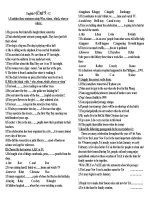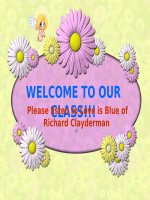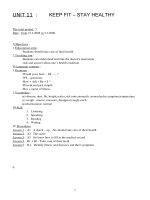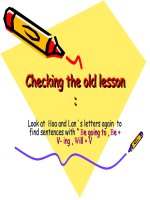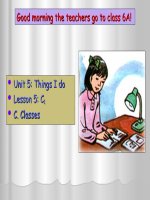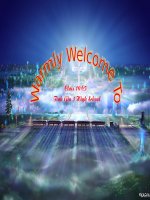- Trang chủ >>
- Mầm non >>
- Mẫu giáo nhỡ
Unit 5Cultural identity
Bạn đang xem bản rút gọn của tài liệu. Xem và tải ngay bản đầy đủ của tài liệu tại đây (166.74 KB, 14 trang )
<span class='text_page_counter'>(1)</span>Date of preparation: December 2nd Distributive period: 41. Unit 5 Lesson 1. Date of signing: December 5th Date of teaching:. cultural identity Getting started. A. Objectives: 1. Language focus To help Ss to know the overall topic of Unit 5: “Cultural identity”, some vocabulary related to Cultural identity - To check students’ comprehension thorough questions and answers - To help learners get started with some language items in Unit 5 2. Skills - To help learners get started with 4 skills in Unit 5. - Reading: Reading for general ideas and specific information in a passage about cultural identity in today’s modern society. - Speaking: Talking about the ways to maintain cultural identity. - Listening: Listening for specific information in a talk about cultural diversity in a Asian country. - Writing: Writing an essay about the most important feature that defines someone’s cultural identity. 3. Attitudes - To help Ss get started for Unit 5 with the topic " Cultural identity " - To provide Ss some motivation B. Preparations: - Teacher: Handouts, textbook, lesson plan, pieces of papers and cassette. - Students: Textbook C. Methods: - The whole lesson: Integrated, mainly communicative. D. Procedures: Time/Stages Activities Interactions 1. Warm up 5 minutes. Look at the picture and guess who they are and what they are talking about. They are three students and their teacher. They are probably talking about Japanese culture. 2. New lesson 7 minutes. Activity 1: Listen and read. - T. plays the recording, asks Ss to listen and read silently. - Ss listen and read silently. - T. tells Ss that they are going to listen to a conversation between Mr Brown, Van. Lam and Yumi.. T <--> Ss. T <--> Ss Whole class. Activity 2: Complete the diagram:. 10 minutes. - T ask students to complete the diagram individually first, and then compare their answers with a partner. Key: 1. Language 2. Food 3. Clothing 4. Beliefs 5. Cultural practices Activity 3: Answer the following questions - T. asks Ss to read the questions, and underline any key words. before they scan the conversation for the answers. - Ss read the questions, underline any key words and scan the conversation for the answers.. Individually. T <--> Ss. Keys:. 1. Because it’s essential to understand their family history and traditions. 2. They wear kimonos on special occasions and celebrate Japanese festivals. They eat sushi, sashimi and udon noodles. They also speak Japanese at home.. Individually or.
<span class='text_page_counter'>(2)</span> 10 minutes. 10 minutes. 3. She doesn’t know whether her home is Japan, where her parents come from, or Viet Nam, where she was born and grew up. 4. (Suggested answer): Language: Vietnamese; food: square and round sticky rice cakes, pho; clothing: ao dai, ao ba ba; beliefs: ancestor worship; cultural practices: Hung Kings’ Festival, Quan ho singing.. Pair work. T <--> Ss. Activity 4: Find the verb or adjective that goes with each of the following nouns or noun phrases. If necessary, use a dictionary to check the meaning.. - This activity focuses on the collocations used in the conversation. - T asks students to read the conversation again and find the verbs or adjectives that go with the given nouns or noun phrases. Key: 1. express/ protect 2. traditional 3. cultural 4. understand 5. maintain. Activity 5: Read the conversation again and write the correct tenses of the verbs in brackets.. Individually. - T asks students to write the correct tenses of the verbs in brackets first, and then has them read the conversation to check their answers. Key: 1.have been living/ have lived 2. ’ve been. T <--> Ss. Consolidation. - Ask Ss: What have you learnt today? What can you do now? - Summarize the main points of the lesson.. T <--> Ss. 1 minute. - Ask Ss to learn by heart the words or phrases related to the topic - Prepare for the next lesson.. T <--> Ss. 3. 2 minutes 4. Homework E. Experience:. ................................................................................................................................................................................... ................................................................................................................................................................................... .................................................................................................................................................................................... Date of preparation: December 2nd Distributive period: 42. Unit 5 Lesson 2. Date of signing: December 5th Date of teaching:. cultural identity Language. A. Aims and Objectives: 1. Language focus - To provide learners some language items in Unit 5 - For vocabulary, that is words and phrases related to Cultural identity - For pronunciation, that is the assimilation in connected speech - For grammar, that is the present perfect vs. the present perfect continuous tense and repeated comparatives. 2. Skills - To promote Ss to develop the skill of working in pairs and groups 3. Attitudes - To encourage Ss to work harder - To provide Ss some motivation B. Preparations: - Teacher: Handouts, textbook, pieces of papers, lesson plan and cassette. - Students: Textbook C. Methods: - The whole lesson: Integrated, mainly communicative..
<span class='text_page_counter'>(3)</span> D. Procedures: Time/Stages 1. Homework 3 minutes. Activities. - T spells some words, asking Ss to try to recognize them - Ss try to recognize them - T. asks Ss to read the context provided to do the task. - T asks Ss to do exercises on workbook.. 2. New lesson A. Vocabulary: Activity 1: Write the words or phrases given in the box next to 7 minutes their meanings.. - T asks students to match the words or phrases with their meanings. - T checks answers as a class. If necessary, ask a few Ss to say the equivalent meaning of these words and phrase in Vietnamese. Key: 1. national costumes 2. assimilate 3. custom 4. maintain 5. cultural practices 6. multicultural Activity 2: Complete the sentences with the correct forms of the words in 1. 1. - Sts do as required, bearing in mind a verb or a noun must be used. 7 minutes. its suitable form (e,g. verb tense, singular or plural form of nouns). - T asks Ss to complete the sentences individually. Alternatively, in a weaker class, T has Ss work on the sentences in pairs. - Sts find the suitable words to fill in the gaps. - T checks answers as a class. Key: 1. cultural practices 2. custom 3. national costumes 4. maintain 5. multicultural 6. assimilated 2. Pronunciation: Assimilation Activity 1. The following phrases are spoken in low, careful speech and in fast, connected speech. Listen and repeat. Pay attention to the pronunciation of the underlined sounds. - T tells students that they are going to listen to six phrases spoken in two different ways: slow, careful speech (with no assimilation) and fast, connected speech (with assimilation) - T asks students to listen and repeat - Ss repeat chorally and individually. 10 minutes. T <--> Ss. Individually. T <--> Ss. Individually. T <--> Ss. Individually/ or Pair work. Activity 2: Listen and repeat the following sentences spoken in fast, connected speech. - T plays the recording for Ss to repeat chorally and individually. - Ss listen and repeat the following sentences, paying attention to the assimilation. 2. Grammar: The present perfect and present perfect continuous. Activity 1: Put the verbs in brackets in the present perfect or present perfect continuous.. -T has students review the uses of the present perfect and the. 15 minutes. Interactions. present perfect continuous tenses -T asks students to study the remember box and draw their attention to the rules and examples. -T asks students to read each sentence carefully and decide whether the focus is on the action/ event or the result of the action/ event. Draw their attention to the time expression used in sentences 2,4,8 (for many years, all morning, for hours) Key: 1. have cleaned 2. have been trying 3. has stood 4. has been working, has planted 4. have gone 6. haven’t finished. T <--> Ss. Pair work. T <--> Ss. Individually.
<span class='text_page_counter'>(4)</span> Activity 2: Complete the following sentences with the correct forms of the words in brackets, using repeated comparatives .. - T asks students to complete the sentences, using the words in brackets and the structure of repeated comparatives. Key: 1. better and better 2. higher and higher 4.More and more 5. More and more difficult 6.faster and faster 7.fewer and fewer 8.more and more. Ss <--> Ss. Activity 3: Put the verbs in brackets in the correct tenses.. - Use the given information to complete the sentences with repeated comparatives - T asks students to study the information in the table and makes sure they understand the increasing or decreasing trend in each situation - T asks students to read the sentences and think of a suitable verb, adjectives/ adverb, or determiner (more/fewer) that can be used in each sentence - T has students do the activity individually first, and then compare the answers in pains. T checks answers as a class. Key: 1. is becoming colder and colder 2. are becoming lower and lower 3. More and more people 4. was driving faster and faster 5. Fewer and fewer customers. 3. Consolidation. 2 minutes. 4. Homework 1 minute. - Ask Ss: What have you learnt today? What can you do now?. - Summarize the main points of the lesson. Expected answers: + I can use: Assimilation in connected speech The present perfect and present perfect continuous - T asks Ss to do exercises again at home. - Prepare for the next lesson. - Complete Exercises in workbook.. T <--> Ss. Individually. Ss <--> Ss. T <--> Ss. T <--> Ss. E. Experience: ................................................................................................................................................................................... ................................................................................................................................................................................... .................................................................................................................................................................................... Date of preparation: December 2nd Distributive period: 43. Date of signing: December 5th Date of teaching:. Unit 5 cultural identity Lesson 3 Reading A. Aims and Objectives: - To teach Ss to scan a text for specific information in a passage about cultural identity in today’s modern society..
<span class='text_page_counter'>(5)</span> - To teach Ss new vocabulary by answering questions. - To develop their reading skill through choosing the main idea for each paragraph. - To learn new vocabulary by finding words or expressions with the meanings given. B. Preparations: - Teacher: Handouts, textbook, pieces of papers, lesson plan and cassette. - Students: Textbook C. Methods: - The whole lesson: Integrated, mainly communicative. D. Procedures: Time/Stages Activities Interactions 1. Lead-in 8 minutes. 2. New lesson 17 minutes. T informs the class of the lesson objectives: skimming and scanning an article for general ideas and specific information, and learning additional vocabulary and information related to the cultural identity Ss work in pairs, look at the vocabulary items in the word bank and discuss their meanings. Cultural identity in modern society. Activity 1: Use a dictionary to find the meaning of the words or phrases in the box. Then complete the sentences with their correct forms.. -T has students use a dictionary to find the meanings of the words in the box, if necessary, and complete the sentences with the correct forms of these words. T checks answers as a class. Key: 1. for granted 2. cultural identifiers 3. identity 4. integrated 5. aspects. Activity 2: Read the newspaper column about cultural identity. Four sentences have been removed from the column. Choose a sentence (a-d) to complete each gap (1-4). 12 minutes. T <--> Ss. -T tells students that they are going to read a newspaper column about cultural identity in today’s modern society and explains that the text has four sentences (a-d) removed from it. -T asks students to read through the sentences (a-d) and underline key words or words used for reference (determiners, nouns, verbs, etc.) -T has students read each paragraph of the text and look for information before and after each gap that is connected to the key words, reference words or linking words students underlines in the sentences (a-d) -T asks students to complete the gap individually, then compare answers in pairs, and read the entire text to ensure that each sentence fits well and the information is coherent. -T checks answers as a class. Key: 1.b 2.d 3.c 4.a. Pair work. T <--> Ss. Pair work. T <--> Ss. Activity 3: Read the newspaper column again and answer the questions. Individually/. 5 minutes. -T has students work in pairs and practice asking and answering the questions. Key: 1. They define themselves by (cultural identifiers such as) nationality ethnicity, location, history, language, gender, beliefs, customs, clothing and food. 2. In this stage, culture is taken for granted. Cultural ideas and values provided by families, communities or the media are easily. Pair work.
<span class='text_page_counter'>(6)</span> accepted without much critical thinking. 3. They may become more curious, and willing to explore, analyses and compare their beliefs with other cultures. 4. When they develop a clear sense of cultural identity, know which social group they belong to, and feel satisfied with their cultural identity. 5. Because access to the Internet and the media provides instant contact with many cultures. 6. First, they keep their cultural identity. Second, they assimilate into the new culture of the majority. Third, they integrate into the new cultural environment (keeping their cultural identity and flexibly adjusting to the different aspects of the new culture). Activity 4: What should young people do to develop their cultural identity in today’s modern society? Discuss with a partner.. T <--> Ss. Group work. - T has students work in pairs/ groups. And encourages them to think of more ideas/ activities to develop their cultural identity in today’s modern society. - T has some pairs/ groups summarize their discussion and present the main points/ ideas to the rest of the class.. T <--> Ss. - Summarize the main points of the lesson. T <--> Ss. - Ask students to learn by heart the new words. - Prepare for the next lesson.. T <--> Ss. 3.. Consolidation. 2 minutes 4. Homework 1 minute E. Experience:. ................................................................................................................................................................................... ................................................................................................................................................................................... .................................................................................................................................................................................... Date of preparation: December 2nd Distributive period: 44. Date of signing: December 5th Date of teaching:. Unit 5 cultural identity Lesson 4 Speaking. A. Aims and Objectives: - To teach Ss to talk about some activities that can help maintain cultural identity. - To teach Ss to practise sharing and giving responses to new information. - By the end of the lesson, students will be able to: + Express their opinion about some activities that can help maintain cultural identity. + Perform their viewpoints to other people in real life. B. Preparations: - Teacher: Handouts, textbook, lesson plan and pieces of papers. - Students: Textbook C. Methods: - The whole lesson: Integrated, mainly communicative..
<span class='text_page_counter'>(7)</span> D. Procedures: Time/Stages Activities 1. Homework - Check students’ work books 8 minutes. Interactions T <--> Ss. 2. New lesson. Activity 1: Work with a partner .Discuss and decide if these. 10 minutes. activities can help to maintain cultural identity. Can you add any more activities?. Individually. -T asks students to work in pairs. T has them discuss and decide if the activities can help maintain cultural identity especially in situations when people are away from their home countries. -T encourages students to add more activities. Suggested answers 6. Singing/ Listening to folk songs 7. Reading heritage folklore 8. Conserving heritage sites. T <--> Ss. 11 minutes. Maintaining cultural identity. Activity 2: Work in pairs. Talk about why each of the activities in 1 is important.. 13 minutes. -T has students work with a partner. Start the activity by giving students enough time to read the example. -T asks students to pay attention to the way the speaker talks about the importance of one of the activities provided in 1. -T encourages them to talk about why the activities in 1 (or their suggested activities) are important maintaining cultural identity Example: I think it’s important to preserve our native language. It’s a vital part of culture and it is critical to a person’s cultural identity. Our first language helps us to develop intellectual abilities and shape our cultural identity. It enables us to communicate, establish links with family and community members, and acquire and value native culture. Activity 3: Work in groups of three. Choose an activity in 1. Discuss how it will help to maintain cultural identity in the age of globalization. Use the reasons discussed in 2 and any information you may want to add.. 3.. Consolidation. 2 minutes. -T asks students to work in groups of three. Give them enough time to practice reading the example. -T has them choose one activity first, and then discuss how it will help to maintain cultural identity in the age of globalization. -T encourages them to use the reasons they have discussed in 2 and any additional information they may want to add. - Summarize what they have learnt by asking Ss some questions: What have you learnt today? What can you do now?. 4.Homework - Ask students to learn by heart the expressions. 1 minute - Prepare for the next lesson.. Pair work. T <--> Ss. Group work. Ss <--> Ss. T <--> Ss T <--> Ss. E. Experience: ................................................................................................................................................................................... ................................................................................................................................................................................... .................................................................................................................................................................................... Date of preparation: December 2nd. Date of signing: December 5th.
<span class='text_page_counter'>(8)</span> Distributive period: 45. Date of teaching:. Unit 5 cultural identity Lesson 5 Listening A. Aims and Objectives: - To develop Ss’ skill of listening to for general ideas and specific information in a talk about cultural diversity in an Asian country - To help Ss understand general ideas and specific details to answer comprehension questions. - By the end of the lesson, students will be able to: + Listen and do the tasks. + Develop the listening skills for specific details. + Identify specific information through multiple-choice task and question answering B. Preparations: - Teacher: Handouts, textbook, pieces of papers and cassette. - Students: Textbook C. Methods: - The whole lesson: Integrated, mainly communicative. D. Procedures: Time/Stages Activities Interactions - Inform the class of the lesson objectives: listening for specific 1. Lead-in information in a conversation between two students talking about 7 minutes their uses of social media and how they use it for language T <--> Ss learning. 2. New lesson. Cultural diversity in Singapore Task 1: You are going to listen to a talk about cultural. 10 minutes. diversity in Singapore. What do you know about this citystate? Look at the information below and describe Singapore. 13 minutes. T has students work individually or in pairs to summarize the information and describe the pie chart. T encourages students to add any additional information that they may know from either reading about or visiting Singapore. T tells students that the activity provides some vocabulary and information that they may need for the listening activity.. Pair work. T <--> Ss. Key: 1. Eurasians and other 2. Indians 3.Malays 4. Chinese Task 2: Work in pairs. Discuss and match the national costumes with their names.. -T focuses Ss’ attention on the pictures and has them do the matching first individually, and then check with a partner. Key: 1.d 2.a 3.c 4.b. Pair work. T tells students that the activity focuses on listening for general ideas. Have them trade the question and make some guesses about the content and the structure of the listening text. T checks student’s comprehension to make sure they are familiar with the language. - T plays the recording non-stop so students can get the gist of the talk. T has students compare answers in pairs, and then check answers as a class. Key :1.v 4.v 6.v. T <--> Ss. Task 3: Listen to a talk. What is the speaker talking about? Tick the correct boxes.. 12 minutes. Task 4: Listen again and answer the following questions.
<span class='text_page_counter'>(9)</span> 1. When did Singapore become an independent country? 2. What is Singapore’s national costume? 3. Who used to wear the cheongsam? 4. How is the sari worn? 5. What is the office attire for men and women in Singapore? 6. How do young Singaporeans think of themselves? -T tells students that the activity focuses on listening for specific information.. - T has students work in pairs first, and then checks their answers as a class. Key: 1. Singapore gained its independence on 9 August 1965. 2. Singapore does not have a national costume, as people from the different ethnic groups tend to wear their traditional clothing. 3. Both Chinese men and Chinese women used to wear cheongsam. 4. It’s wrapped around the waist and hung over the shoulder. 5. Men usually wear dark trousers, white shirts and a tie while women wear long-sleeved blouses skirts. 6. The young people often think of themselves as Singapore first, and then as Chinese, Malay or Indian. 3.. Individually. T <--> Ss. 2 minutes. - Ask Ss to consolidate the main contents. - Ask Ss: What have you learnt today? What can you do now?. T <--> Ss. 4. Homework 1 minute. - Prepare for the next lesson.. T <--> Ss. Consolidation. E. Experience: ................................................................................................................................................................................... ................................................................................................................................................................................... .................................................................................................................................................................................... Date of preparation: December 2nd Distributive period: 46. Date of signing: December 5th Date of teaching:. Unit 5 cultural identity Lesson 6 Writing. A. Aims and Objectives: - To develop Ss’ skill of writing an argumentative essay about the most important feature that defines someone’s cultural identity. - To provide Ss with the language and sentence structures used to describe trends. - By the end of the lesson, students will be able to: + Learn about an essay about the most important feature that defines someone’s cultural identity. + Develop the writing skills in general. Build up vocabulary supported for writing. B. Preparations: - Teacher: Handouts, textbook, lesson plan and pieces of papers. - Students: Textbook C. Methods: - The whole lesson: Integrated, mainly communicative. D. Procedures: Time/Stages Activities Interactions.
<span class='text_page_counter'>(10)</span> 1. Check up 5 minutes. The lesson objective: Writing an argumentative essay about the most important feature that defines someone’s cultural identity.. 2. New lesson. Task 1: Work in pairs. Discuss the reasons why language is. 7 minutes. 10 minutes. T <--> Ss. What makes me Vietnamese. often considered the most important cultural identifier.. - T tells students that they can refer back to the reading and other previous sections to get ideas. - T asks students to read the example and discuss why language is considered the most important cultural identifier. - T encourages students to share their ideas and says if they agree or disagree with the examples. Example: Language is the most important cultural identifier because it allows me to communicate with my family and community. Task 2: Read the following argumentative essay on. Pair work. T <--> Ss. language as defining a person’s cultural identity. Complete the essay, using the correct forms of the words in the box. 15 minutes. - T tells students that they are going to read an argumentative essay. Allow enough time for them to read through the text and work out the essay structure -T asks students to use a dictionary to check the meaning of difficult words and phrases. - T checks answers as a class. Key 1. Expressing 2. Demonstrate 3. Features 4. Unite 5. Share 6. Invaded 7. Unifying 8. Unique Task 3: Which is the most important cultural identifier or the feature that defines your cultural identity? First, discuss your ideas in groups of four. Then decide on the most important feature and write an argumentative essay of about 180-250 words.. - T encourages students to incorporate the feedback and write the first draft in full sentences. Then asks students to read their drafts in their groups so other group members can comment on content, grammar and vocabulary use .T walks around and provides help by correcting mistakes in grammar or word choice. - T asks students to work independently and write their final essays incorporating all the feedback from students and teacher - T invites some students to read their essays. Have the rest of the class ask question or say what they like most about the piece of writing. - Ss can choose one of the following cultural identifiers: - Festivals and cultural practices - Shared values and beliefs - Traditional food - History - Education Introduction Definition of cultural identity…………… Thesis statement………… Body. Individually or Pair work. T <--> Ss. Individually. T <--> Ss.
<span class='text_page_counter'>(11)</span> First argument…………………………… Second argument……………………… Conclusion Summary of the arguments 3. - Ask Ss to consolidate the main contents. Consolidation - Ask Ss to complete the writing at home and collect 2 minutes - Ask Ss: What have you learnt today? What can you do now? 4.Homework - Write the text again at home. 1 minute - Prepare for the next lesson.. T <--> Ss. T <--> Ss. E. Experience: ................................................................................................................................................................................... ................................................................................................................................................................................... .................................................................................................................................................................................... Date of preparation: December 2nd Distributive period: 47. Unit 5 Lesson 7. Date of signing: December 5th Date of teaching:. cultural identity Communication and culture. A. Aims and Objectives: 1. Language focus - To provide learners some communication samples and cultural items 2. Skills - To promote Ss to develop their communication skills and cultural understanding - To help Ss develop the skill of working in pairs and groups 3. Attitudes - To encourage Ss to work harder - To provide Ss some motivation - By the end of the lesson, students will be able to: + Understand and communicate about communication skills and cultural understanding. + Talk about the migration and cultural identity and know about the festivals that help ethnic groups in Vietnam to maintain their cultural identity. B. Preparations: - Teacher: Handouts, textbook, lesson plan and pieces of papers. - Students: Textbook C. Methods: - The whole lesson: Integrated, mainly communicative. D. Procedures: Time/Stages Activities Interactions - Inform the class of the lesson objectives: Further skill 1. Warm up 5 minutes development T <--> Ss 2. New lesson 17 minutes. 1. Communication: Migration and cultural identity Activity 1: Listen to a talk by Mr Ben Wilson, a sociologist and psychologist, about preserving migrants’ cultural identity. Answer the questions.. - Tell students that they are going to listen to a talk by Mr Ben Wilson about preserving migrants’ culture identity. - Ask students to read the questions and underline the key words so they can get a general idea of the talk. - Play the recording once or twice for students to take notes of their answers. Activity 2: Discuss the questions with a partner.. Pair work. T <--> Ss.
<span class='text_page_counter'>(12)</span> 20 minutes. - Ask students to work with a partner to compare their answers. Check answers as a class. 2. Culture: Festivals Activity 1: Read the text about celebrations of some ethnic groups in Viet Nam. Write the names of the festivals under the pictures.. - T asks students what the people in the photos are doing. T lets them guess where in Viet Nam these events may take place. - T has students read the text quickly and write the names of the festivals under the photos. Key: a. Elephant Racing Festival b. Forest Worshipping Festival. Group work. Activity 2: Read the text again and complete the table.. - T asks students to study the table and consider what kind of information they need to write in it. - T asks students to read the text again and complete the table. T checks answers as a class. Key: Elephant Racing Festival Location: Dak Lak Province Time: annually, in March Ethnic groups: M’Nong and Ede Purpose: to promote the martial spirit of the M’Nong and Ede people Activities: - watching elephant race - Eating traditional food and drinking rice wine - Dancing - Watching elephants play soccer Activity 3: Discuss the questions with a partner. T <--> Ss. Pair work. T <--> Ss. - T has students discuss the questions in pairs. - After their discuss, T asks some pairs to report their experiences and opinions to the class. T <--> Ss 3.. - Ask Ss to consolidate the main contents. - Ask Ss: What have you learnt today? 2 minutes What can you do now? - Elicit answer: I have improved my listening, speaking and reading skills. I can talk about the educational values of videos for learning English. I can also talk about social media apps for communication, entertainment and security. 4.Homework - T asks Ss to learn the structures and vocabulary. 1 minute - Prepare for the next lesson. Consolidation. T <--> Ss. T <--> Ss. E. Experience: .................................................................................................................................................................................... Date of preparation: December 2nd Distributive period: 48. Unit 5 Lesson 8. Date of signing: December 5th Date of teaching:. cultural identity Looking back and project. A. Aims and Objectives: - To help Ss pronounce revise what they have learned in unit 5. - To teach Ss some lexical items related to the cultural identity..
<span class='text_page_counter'>(13)</span> - To give them a chance to do a small project in which they can develop their speaking skills - To help Ss review and recognize the assimilation in connected speech. - To help Ss consolidate the use of simple past tense and past perfect tense. - To provide further opportunities for Ss to use the language, skills and information they have learnt in the unit 5. - By the end of the lesson Ss are able to: + Use some key words of the cultural identity. + Do the exercises on present perfect tense and present perfect continuous tense, repeated comparatives. B. Preparations: - Teacher: Handouts, textbook, pieces of papers, lesson plan and cassette. - Students: Textbook C. Methods: - The whole lesson: Integrated, mainly communicative. D. Procedures: Time/Stages Activities Interactions -T informs the class the objectives: reviewing pronunciation, 1. Warm-up vocabulary and grammar. T <--> Ss 5 minutes - T reviews from and use of simple past tense and past perfect tense. 2. New Pronunciation: Activity 1: Underline the sounds that can be affected by lesson assimilation.. 8 minutes. 9 minutes. - T helps students to review the process of assimilation in this unit (/t,d,n/ before /k,g/; /s,z/ before /s,j/) - T has students read the sentences and underline the sounds that can be affected by assimilation. - T asks students to work with a partner to compare their answers. T checks answers as a class. Activity 2: Listen and repeat the sentences in 1 -T plays the recording and has students listen and repeat. -T asks some students to say these sentences aloud. Vocabulary:. Individually. T <--> Ss. Activity 1: Complete the sentences with the correct forms of the words or phrases in the box. 12 minutes. -T gives comments and praises students who can say the sentences naturally and fluently, and try to blend the final and initial sounds. -T has students read the instructions and do the activity individually. Then ask them to compare their answers in pains. -T checks answers as a class. Key: 1. preserve 2. cultural identity 3. cultural practices 4. national pride 5. Solidarity 5. national costume Grammar: Activity 1: Read the exchanges. Put the verbs in brackets in. Pair work. T <--> Ss. the present perfect or present perfect continuous. Use the passive voice if necessary.. -T asks students to read through the three exchanges before deciding on the correct tense for each verb. -T has students do the activity individually first, and then compare their answers in pains. -T checks answers as a class. Key: 1. has become, have continued, has been working 1. Have never seen, have worn, has even become Activity 2: Read the situation and complete Andy’s. Pair work.
<span class='text_page_counter'>(14)</span> statements about himself, using repeated comparatives.. 8 minutes. -T tells students that they are going to write sentences about someone called Andy. -T asks students to read the situation and the example first. T asks comprehension questions to check if they understand the activity context. -T has students complete the sentences, using the words in brackets to form repeated comparatives to express the changes that Andy is going through. -T allows students to do the activity individually first, and then compare their sentences in pains. - T checks answers as a class. Key: 2.lower and lower 3. more and more difficult 4.more and more complicated 5. More and more 6. less and less Project:. T <--> Ss. Pair work. T <--> Ss. Work in groups of four or five. Choose one ethnic group in Viet Nam. Look for information about the features that define the group’s cultural identity.. 3. Consolidation. 2 minutes. 4.Homework 1 minute. -T has students work in groups of four or five -T allows students one week to collect the information about an ethnic group, prepare a poster, and organize their presentation about the ethnic group. - Ask Ss to consolidate the main contents. - Ask Ss: What have you learnt today? What can you do now? - T asks Ss to learn the structures and vocabulary. - Prepare for the next lesson.. Group work. T <--> Ss T <--> Ss. E. Experience: ................................................................................................................................................................................... ................................................................................................................................................................................... ....................................................................................................................................................................................
<span class='text_page_counter'>(15)</span>

